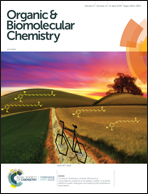Elevated reaction order of 1,3,5-tri-tert-butylbenzene bromination as evidence of a clustered polybromide transition state: a combined kinetic and computational study†
Abstract
The kinetics and mechanism of concurrent bromo-de-protonation and bromo-de-tert-butylation of 1,3,5-tri-tert-butylbenzene at different bromine concentrations were studied experimentally and theoretically. Both reactions have high order in bromine (experimental kinetic orders ∼5 and ∼7, respectively). According to quantum chemical DFT calculations, such high reaction orders are caused by participation of clustered polybromide anions Br2n−1– in transition states. Bromo-de-tert-butylation has a higher order due to its bigger reaction center demanding clusters of extended size. A significant primary deuterium kinetic isotope effect (KIE) for bromo-de-protonation is measured indicating proton removal is rate limiting, as confirmed by computed DFT models. The latter predict a larger value for the KIE than measured and possible explanations for this are discussed.

- This article is part of the themed collection: Mechanistic, computational & physical organic chemistry in OBC


 Please wait while we load your content...
Please wait while we load your content...